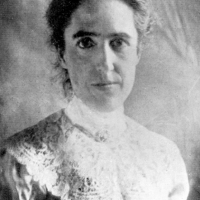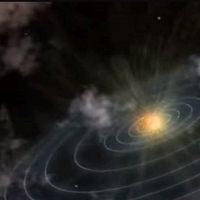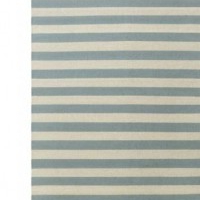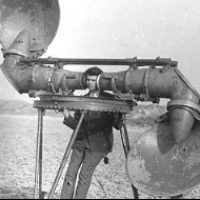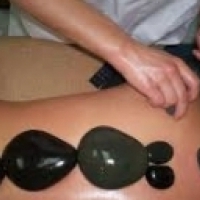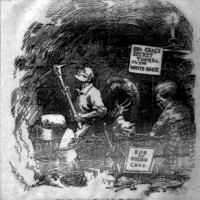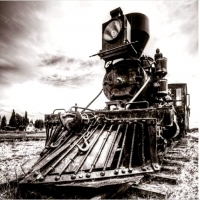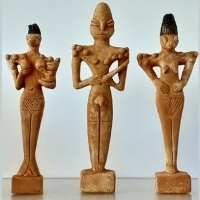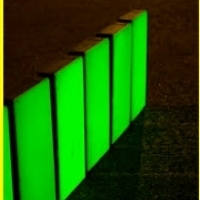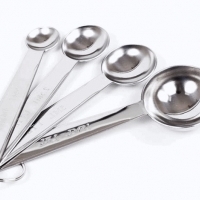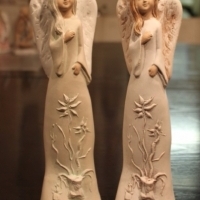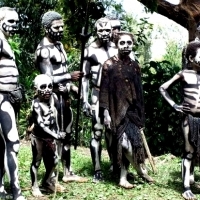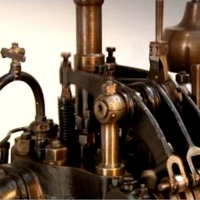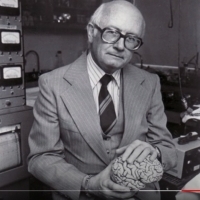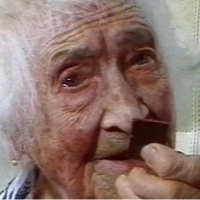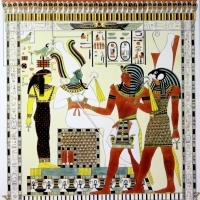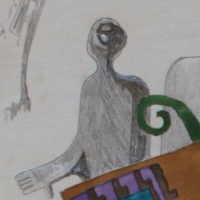0 : Odsłon:
Kiedyś myśleliśmy, że Droga Mleczna jest jedyną galaktyką, ale z jednym prostym prawem Henrietta Swan Leavitt zmieniła to na zawsze - a ona nawet nie potrzebowała teleskopu.
A
Sto lat temu Wszechświat wydawał się znacznie mniejszym miejscem. Wielu astronomów było przekonanych, że nasza macierzysta galaktyka Drogi Mlecznej składa się z całego kosmosu. Zmieniło się to w 1923 roku, kiedy astronom Edwin Hubble usiadł na szczycie Mount Wilson w Kalifornii i skierował teleskop obserwatorium w kierunku rozmytej jasnej spirali na odległym nocnym niebie, Mgławicy Andromedy.
Andromeda, Hubble zauważył, był zbyt daleko, aby być częścią Drogi Mlecznej. To nie była mgławica, ale galaktyka. Galaktyka Andromedy oddalona o około 2,5 miliona lat świetlnych od Ziemi. Niezwykła obserwacja Hubble'a nie byłaby możliwa bez pracy Henrietty Swan Leavitt, która nie korzystała nawet z teleskopu.
Zamiast tego Leavitt użył lupy skierowanej – nie w górę, ale w dół – na delikatnej szklanej płycie przymocowanej do drewnianej ramy. Jedna strona szklanej płyty była pokryta emulsją fotograficzną i usiana upiornym nadrukiem tysięcy gwiazd uchwyconych na jej powierzchni. Czarne gwiazdy oświetlone na białej powierzchni odsłaniają odwrócenie nocnego nieba oglądanego gołym okiem. W ten sposób Leavitt doświadczył Wszechświata.
Leavitt była jednym z wielu "ludzkich komputerów" pracujących w Harvard College Observatory na przełomie XIX i XX wieku. Ta grupa, wszystkie kobiety, odkryła dziesiątki nowych nowych novae, mgławic i planetoid, a także tysiące "gwiazd zmiennych", które są definiowane przez ich woskowanie i słabnącą jasność. Leavitt, która była kiedyś opisywana jako "zmienna gwiazda-fiend", odkryła ponad 2000 gwiazd zmiennych. A jej polowanie na gwiazdy doprowadziło ją do jeszcze większej nagrody – metody pomiaru odległości w przestrzeni kosmicznej.
Znane jako relacja między okresem a jasnością, spostrzeżenia Leavitta pozwoliły astronomom zmierzyć odległość na skalę międzygalaktyczną i dały Hubble'owi formułę, którą musiał zobaczyć poza naszym sąsiedztwem i do Wszechświata poza nią. "Całe nasze postrzeganie Wszechświata całkowicie zmieniło się w wyniku jej odkrycia", mówi Wendy Freedman, astronom i astrofizyk z University of Chicago.
Po zainteresowania się astronomią w swoim starszym roku, Leavitt rozpoczęła praktykę w Harvard College Observatory w 1895 roku, w wieku 27 lat. W tym czasie, coraz więcej kobiet, takich jak Leavitt były ukończeniu z wyższymi stopniami, według historyka Margaret Rossiter, który badał role kobiet w nauce na przełomie 20 wieku. Nadal byli w dużej mierze wykluczeni z nauczania na uniwersytetach i stanowiskachkierowniczych, ale wydziały astronomii były zbyt szczęśliwe, aby je wspierać ich "duże nauki" projekty, które wymagały dużej liczby nisko opłacanych pracowników.
Leavitt został zwerbowany przez dyrektora Harvard Observatory, Edwarda Pickeringa, który prowadził wieloletni projekt fotografowania całego nocnego nieba, a następnie klasyfikował i katalogował widmo swoich gwiazd.
Zgodnie z XIX-wiecznymi rolami płci, kobiety były postrzegane jako idealne kandydatki do tej pracy klasyfikacyjnej, co wymagało cierpliwości i dbałości o szczegóły – cech, które uważano za ucieleśniające w sposób naturalny. Mężczyźni, w międzyczasie, uważano, że są bardziej zorientowani na przywództwo i intelektualnej pracy obserwacji i teorii.
Stanowiska takie jak Leavitt były zazwyczaj nisko płatne i niskiej rangi, z mało lub nie ma miejsca na awans. Na tych stanowiskach, kobiety mogą stosować swoje "kobiece" umiejętności bez stwarzania zagrożenia dla swoich kolegów płci męskiej, zarówno w prestiżu, ani w wynagrodzeniu.
Leavitt (po prawej) z Annie Jump Cannon, która była jedną z niewielu kobiet, którym pozwolono korzystać z teleskopu Harvarda (Credit: Alamy)
Rzeczywiście, kiedy Pickering postanowił spakować swój personel z kobietami, to jest to, co miał na myśli. "Aby osiągnąć największą wydajność, umiejętny obserwator nigdy nie powinien być zobowiązany do spędzania czasu na tym, co może być zrobione równie dobrze przez asystenta przy znacznie niższym wynagrodzeniu", napisał Pickering w 1898 roku w rocznym raporcie Harvard Observatory. Płacił komputerom 25 centów za godzinę, około 1500 dolarów rocznie, podczas gdy ludzie z Obserwatorium zarabiali co najmniej 2500 dolarów rocznie.
Oprócz Annie Jump Cannon, która dołączyła do obserwatorium rok po Leavitt, komputery nie mogły korzystać z teleskopów. Dostosowanie tego sprzętu i uchwycenie zdjęć gwiazd zostało przeprowadzone przez mężczyzn. Płyty ze szkła fotograficznego zostały dostarczone do "sali komputerowej" na drugim piętrze wschodniego skrzydła Obserwatorium do analizy i obliczeń.
Tam kobiety spędzały każdy dzień pochylony nad płytami. Sklasyfikowali widma gwiazd, zmierzyli ich jasność i skatalogowali ich odkrycia. Praca była intensywna, opodatkowana i powtarzalna.
This plate of the Small Magellanic Cloud features notes by Leavitt from her Cepheid variable studies (Credit: Harvard College Observatory, Photographic Glass Plate Collection)
Ta płyta Small Magellanic Cloud zawiera notatki Leavitt z jej badań zmiennych Cepheid (Credit: Harvard College Observatory, Photographic Glass Plate Collection)
Kiedy Leavitt zajęła swoje biurko w sali komputerowej, miała za zadanie określić wielkość (miarę jasności gwiazdy) gwiazd zmiennych w północnym regionie polarnym z samych szklanych płyt. Jednym z powodów, dla których światło tych gwiazd zmienia się, jest to, że pulsują: ściskając i uwalniając gaz w regularnym cyklu. Aby dowiedzieć się, czy gwiazda zróżnicowana,ona wyrównać dwie płyty tego samego skrawka nieba, jeden był czarny-gwiazda ujemna, a druga pozytywne. Gwiazdy będą się anulują, z wyjątkiem tych, które różniły się jasnością. Leavitt jeszcze o tym nie wiedział, ale związek między wzorem zmienności a ogólną wielkością gwiazdy trzymał w tajemnicy ocenę jej odległości od Ziemi.
Przechodząc od gwiazdy do gwiazdy, a następnie płyta na talerz, Leavitt będzie oceniać jasność gwiazdy, porównać ją ze znaną wielkością innych gwiazd i zapisać wyniki na szklanej płycie w swojej księdze. Proces ten, w kółko, jest jak Leavitt spędziła swoje dni w obserwatorium.
Po roku Leavitt opuściła obserwatorium w 1896 roku, aby podróżować po Europie i pracować jako asystentka artystyczna w Beloit College w Wisconsin w pobliżu jej rodzinnego domu. Ale gwiazdy w końcu oddzwonią do niej.
Leavitt nie zostawiła żadnych czasopism ani pamiętników, a jej korespondencja bardziej skłania się ku biznesowi i ujawnia niewiele danych osobowych. Najwyraźniej jednak była głęboko inwestowana w swoją pracę w obserwatorium. Jeden z astronomów opisał ją jako "pochłoniętą w swojej pracy w niezwykłym stopniu". A po sześciu latach odejścia, powiedziała Pickering się, jak bardzo cieszyła się i brakowało jej pracy. "Jest mi bardziej przykro, niż mogę powiedzieć, że praca, którą podjęłam z taką radością i doprowadzona do pewnego momentu, z taką przyjemnością, powinna pozostać niedokończona" - napisała w liście z 13 maja 1902roku.
Leavitt był chętny do podjęcia astronomii ponownie, i zapytała Pickering, czy mógłby znaleźć jej pracę w obserwatorium lub szkole jako nauczyciel astronomii. Jej możliwości nauczania były jednak ograniczone. Przez lata Leavitt doświadczała rosnącego ubytku słuchu, a jej eksarystka nie pozwalała jej obserwować nieba w zimnym nocnym powietrzu, myśląc, że zimno zaostrzyło głuchotę. Nieco zdumiony, że astronomia była uważana za wpływ słuchu i nie może nazwać obserwatorium w ciepłym klimacie, który zabierze ją, Pickering zaproponował jej płatną pracę w obserwatorium na 30 centów za godzinę, pięć centów więcej niż inne komputery. Leavitt przyjął i powrócił na pełny etat w 1903 roku.
Henrietta Swan Leavitt na zdjęciu wykonanym około 1910 roku (Kredyt: Alamy)
Po raz kolejny odebrała swoją pracę nad gwiazdami zmiennymi. Pickering był zainteresowany poszukiwaniem gwiazd zmiennych w mglistych regionach i otrzymał dotację z Carnegie Institution w 1903 roku. Ale Carnegie Institution nie odnowiła dotacji na rok 1904, a Williamina Fleming, starszy komputer i kurator zdjęć astronomicznych, została zmuszona do odwołania wszystkich komputerów, ale Leavitt. Zajmowała się mglistymi regionami, a jej pierwszym zadaniem była Wielka Mgławica w gwiazdozbiorze Oriona.
Przepracowała 10 lat szklanych płyt Mgławicy Oriona i znalazła tam 77 nowych zmiennych. Następnie przeniosła się do mgławicy w Strzelcu i Małego Obłoku Magellana. Latem 1905 roku Scientific American poinformowała, że "Miss Leavitt" znalazła 1300 nowych zmiennych od czasu rozpoczęcia solowej pracy nad mgławicami w lutym 1904 roku.
Do 1908 roku Leavitt kontynuował polowanie na gwiazdy zmienne w Małym Obłoku Magellana i Wielkim Obłoku Magellana. (W tym czasie astronomowie nie wiedzieli, że obie są małymi galaktykami karłowatymi krążącymi wokół Drogi Mlecznej). Znalazła 1777 nowych zmiennych w Chmurach i obliczyła ich minimalną i maksymalną jasność.
To właśnie w tym momencie zobaczyła unikalny wzór. Po skatalogowaniu 16 nowych zmiennych, zauważyła, że im jaśniejsza była gwiazda, tym dłużej trwało ukończenie pełnego cyklu woskowania i zanikania.
The Large Magellanic Cloud as seen with a telescope, rather than a glass plate (Credit: Getty Images)
Duży Obłok Magellana widziany z teleskopem, a nie szklaną płytą (Credit: Getty Images)
Obserwacja ta wydaje się mieć daleko idące konsekwencje, ale Leavitt nie utrzymywał się na nim, ani co to może oznaczać. Złożyła swoje tabele, a następnie wziął urlop z obserwatorium na chorobę, która trwała rok, aby odzyskać od. O tym zjawisku, ona tylko zauważyć w swoim raporcie, "Warto zauważyć, że ... jaśniejsze zmienne mają dłuższe okresy."
Pomiędzy chorobą a przejściem do innych zadań w obserwatorium, Leavitt wciąż myślała o swoich zmiennych gwiazdach w Obłokach Magellana, a trzy lata po swoim pierwszym raporcie powróciła do Małego Obłoku Magellana.
Chociaż Leavitt nie znała dokładnej odległości między Ziemią a gwiazdami na jej płytach, wiedziała, że wszystkie są mniej więcej równie daleko, jako część Małego Obłoku Magellana. To był ważny wniosek, który złożył: oznaczało to, że zmienność ich pozornego woskowania i zanikania nie miała nic wspólnego z odległością – jaśniejsze gwiazdy nie wydawały się jaśniejsze, ponieważ były bliżej, ale dlatego, że były z natury. Aby potwierdzić swoje podejrzenia, nakreśliła pełne cykle zmienności ośmiu kolejnych gwiazd, a jej wniosek był taki sam jak trzy lata wcześniej: im jaśniejsza gwiazda, tym dłuższy okres.
Tym razem Pickering zauważył, a kilka miesięcy później, 3 marca 1912 roku, opublikował obserwację Leavitta na temat "niezwykłej relacji" między jasnością a okresem. To, co zaczęło się jako obiecujący trend, stało się "prawem", zwanym relacją okres-jasność.
Rozszerzający się wszechświat
Leavitt nie teorecje o konsekwencjach jej nowego prawa, przynajmniej nie w każdym zapisie, który pozostaje, ale wiele innych będzie. Stopniowo astronomowie zdawali sobie sprawę, że pozwoliło im to zmierzyć odległość do gwiazd siedzących dalej niż kiedykolwiek wcześniej.
W tym czasie istniała granica tego, jak daleko mogą mierzyć odległość. Gdyby wszystkie gwiazdy były takie same, mogłyby obliczyć ich bliskość według tego, jak jasne się pojawiły, ale ich jasność jest różna. W przypadku gwiazd bliższych mogą zastosować techniki takie jak "paralaksa gwiezdna", która polega na porównywaniu względnego ruchu gwiazd, ale poza pewnym punktem nie jest to możliwe.
Leavitt pokazała, że jej zmienne gwiazdy, zwane Cefeidami, mogą powiedzieć astronomom ich prawdziwą jasność w trakcie ich cyklu, bez względu na to, jak jasne pojawiły się z Ziemi. Tak więc, jeśli odległa galaktyka zawiera Cefeidę – obecnie znaną jako "standardowa świeca" – astronomowie mogą obliczyć jej odległość.
Robią to krokami, zwanymi "kosmiczną drabiną odległości". Po pierwsze, wypracowują odległość do standardowej świecy wystarczająco blisko, aby użyć paralaksy i obliczyć jej jasność. Następnie, zakładając, że standardowa świeca dalej ma ten sam wzór jasności, mogą wywnić jej odległość.
Dziesięć lat po tym, jak Leavitt opublikował swoje prawo, Hubble zwrócił swój teleskop do Andromedy i zobaczył świecę Leavitta płonącą w rozmytym środku. Kiedy zauważył zmienną Cepheid, był w stanie obliczyć odległość Andromedy od Ziemi za pomocą prawa Leavitta i udowodnić, że leży daleko poza naszą Drogą Mleczną. Stosując tę samą metodę, szybko udało mu się znaleźć i zmierzyć 23 kolejne galaktyki, niektóre z nich do 20 milionów lat świetlnych od Ziemi. Gdy prawo Leavitta stanowiło podstawę do budowy, Hubble odkrył również w 1929 roku, że Wszechświat się rozszerza.
Niestety Leavitt zmarła, zanim dowiedziała się, jak ważne będzie jej prawo dla astronomii (Credit: Alamy)
"[Prawo Leavitta] stało się podstawą, dla której mierzyliśmy odległości, galaktyki, od ponad stu lat", mówi Freedman. "Miałeś tylko dwuwymiarowy obraz nieba, a to dało trójwymiarowy obraz po raz pierwszy. Można by zmierzyć ten trzeci wymiar, jak daleko są gwiazdy."
Sama Freedman opiera się w dużej mierze na Cepheidach Leavitta we własnej pracy. Zanim Kosmiczny Teleskop Hubble'a został wystrzelony w 1990 roku, astronomowie wiedzieli, że Wszechświat się rozszerza, ale nie znali jego dokładnego rozmiaru ani wieku. Leavitt po raz kolejny dostarczył rozwiązania. Freedman prowadził projekt wykorzystujący Kosmiczny Teleskop Hubble'a do pomiarów przy użyciu zmiennych Cefeid, osiągając znacznie wyższy poziom dokładności.
Dzięki zdolności do precyzyjnego pomiaru odległości gwiazd zmiennych, Freedman i jej zespół rozstrzygnęli dziesięciolecia debaty na temat epoki Wszechświata. "Znaleźliśmy wiek dla Wszechświata 13,7 miliardów lat."
Elegancki w swej prostocie – im jaśniejsza wielkość, tym dłuższy okres – prawo Leavitta na zawsze zmieniło sposób, w jaki astronomowie patrzą na kosmos. Niestety, Leavitt zmarła na raka żołądka, zanim zobaczyła pełne znaczenie swojego odkrycia. "Jedną z rzeczy, które uważam za najsmutniejsze, jest to, że zmarła w 1921 roku, a Hubble dokonał odkrycia Cepheidów w 1923 roku, a następnie odkrycia ekspansji w 1929 roku", mówi Freedman. "Nigdy nie miała pojęcia, jakie są konsekwencje jej pracy, co było ogromne."
Chociaż Leavitt nie dożyła, aby zobaczyć, jak zmieniła astronomię, ci, którzy przyszli po niej, nie zapomnieli o niej. Cecilia Payne-Gaposchkin, która kontynuowała pracę w gwiazdach zmiennych i odkryła skład Słońca, pracowała w starym biurku Leavitt w 1923 roku i powiedziała o kobiecie, której nigdy nie poznała:"Myślę, że była najbardziej błyskotliwą ze wszystkich kobiet [na Harvardzie]".
Światło standardowych świec Leavitta nadal oświetla drogę astronomów przez stale rozszerzający się Wszechświat. I na cześć, że w 2008 roku, członkowie społeczności astronomicznej, Freedman wśród nich, głosowali, aby zmienić nazwę tego, co wcześniej nazywano okres-jasność relacji do prawa Leavitta.
We used to think the Milky Way was the only galaxy, but with one simple law, Henrietta Swan Leavitt changed that forever - and she didn't even need a telescope.
AND
A hundred years ago, the universe seemed a much smaller place. Many astronomers have believed that our home Milky Way galaxy is made up of the entire cosmos. That changed in 1923 when astronomer Edwin Hubble sat on top of Mount Wilson, California, and pointed the observatory's telescope toward a fuzzy bright spiral in the distant night sky, the Andromeda Nebula.
Andromeda, Hubble noted, was too far away to be part of the Milky Way. It was not a nebula but a galaxy. The Andromeda Galaxy is approximately 2.5 million light-years from Earth. The remarkable Hubble observation would not have been possible without the work of Henrietta Swan Leavitt, who did not even use a telescope.
Instead, Leavitt used a magnifying glass pointing - not up, but down - on a delicate glass plate attached to a wooden frame. One side of the glass plate was coated with photographic emulsion and dotted with the ghostly imprint of the thousands of stars captured on its surface. Black stars illuminated on a white surface reveal the inversion of the night sky when viewed with the naked eye. This was how Leavitt experienced the universe.
Leavitt was one of the many "human computers" at the Harvard College Observatory in the late 19th and early 20th centuries. This group, all women, discovered dozens of new novae, nebulae and asteroids, as well as thousands of "variable stars" that are defined by their waxing and diminishing brightness. Leavitt, who was once described as the "variable star-fiend", discovered over 2,000 variable stars. And her hunt for the stars has led her to an even greater reward - a method of measuring distances in outer space.
Known as the period-luminosity relationship, Leavitt's insights allowed astronomers to measure distance on an intergalactic scale and gave Hubble a formula he needed to see outside of our neighborhood and to the universe beyond. "Our whole perception of the universe has changed completely as a result of her discovery," says Wendy Freedman, astronomer and astrophysicist at the University of Chicago.
After developing an interest in astronomy in her senior year, Leavitt entered Harvard College Observatory in 1895 at the age of 27. During this time, more and more women such as Leavitt were graduating with higher degrees, according to historian Margaret Rossiter, who researched the roles of women in science at the turn of the 20th century. They were still largely excluded from teaching at universities and leadership positions, but the astronomy departments were too fortunate to be supported by their "big science" projects that required large numbers of low-paid workers.
Leavitt was recruited by Harvard Observatory director Edward Pickering, who led a multi-year project of photographing the entire night sky and then classifying and cataloging the spectrum of his stars.
In keeping with the 19th century gender roles, women were seen as ideal candidates for this grading job, which required patience and attention to detail - traits thought to embody naturally. Men, meanwhile, were believed to be more leadership oriented and intellectual work of observation and theory.
Positions like Leavitt have tended to be low paid and low ranking, with little or no room for promotion. In these positions, women can apply their "feminine" skills without endangering their male colleagues, either in prestige or in salary.
Leavitt (right) of Annie Jump Cannon, who was one of the few women allowed to use the Harvard telescope (Credit: Alamy)
Indeed, when Pickering decided to pack his staff with women, that's what he meant. "To achieve the greatest efficiency, a skilled observer should never be required to spend time doing what can be done just as well by an assistant for a much lower wage," Pickering wrote in 1898 in the Harvard Observatory annual report. He paid computers 25 cents an hour, about $ 1,500 a year, while the people of the Observatory were earning at least $ 2,500 a year.
Apart from Annie Jump Cannon, who joined the observatory a year after Leavitt, computers could not use telescopes. Adjusting this equipment and capturing celebrity photos was carried out by men. Photo glass plates have been delivered e to the "computer room" on the second floor of the east wing of the Observatory for analysis and calculations.
There, the women spent each day bending over the plates. They classified the spectra of the stars, measured their brightness, and cataloged their discoveries. The work was intense, taxed and repetitive.
This Small Magellanic Cloud disc features Leavitt's notes on her research on the Cepheid variables (Credit: Harvard College Observatory, Photographic Glass Plate Collection)
When Leavitt took her desk in the computer room, she was tasked with determining the size (a measure of a star's brightness) of the variable stars in the northern polar region from the glass plates themselves. One of the reasons why the light of these stars changes is because they pulsate: compressing and releasing gas on a regular cycle. To find out if a star is differentiated, she would line up two plates of the same patch of sky, one black-negative star and the other positive. The stars will cancel out, except for those that differed in brightness. Leavitt did not know it yet, but the relationship between the pattern of variation and the star's overall size kept his estimate of its distance from Earth a secret.
Moving from star to star and then plate to plate, Leavitt will judge the star's brightness, compare it with the known magnitude of other stars, and record the results on a glass plate in his book. The process, over and over, is how Leavitt spent her days at the observatory.
A year later, Leavitt left the observatory in 1896 to travel around Europe and work as an artistic assistant at Beloit College in Wisconsin near her ancestral home. But the stars will call her back eventually.
Leavitt did not leave any magazines or diaries, and her correspondence is more business-oriented and gives little personal information. Apparently, however, she had been deeply invested in her work at the observatory. One astronomer described her as "engrossed in her work to an extraordinary degree". And after six years of leaving, Pickering said, how much she enjoyed and missed the job. "I am more sorry than I can say that the work I undertook with such joy and brought to a certain point with such pleasure should remain unfinished," she wrote in a letter of May 13, 1902.
Leavitt was eager to take up astronomy again, and asked Pickering if he could find her a job at an observatory or school as an astronomy teacher. However, her teaching opportunities were limited. Over the years, Leavitt had experienced increasing hearing loss, and her exarist kept her from seeing the sky in the cold night air, thinking the cold had made her deafness worse. Somewhat amazed that astronomy was believed to be influenced by hearing and couldn't name a warm-climate observatory that would take her away, Pickering offered her a paid job at the observatory at 30 cents an hour, five cents more than other computers. Leavitt accepted and returned full time in 1903.
Henrietta Swan Leavitt in a photo taken around 1910 (Credit: Alamy)
Once again, she picked up her work on variable stars. Pickering was interested in searching for variable stars in foggy regions and received a grant from the Carnegie Institution in 1903. But the Carnegie Institution did not renew the 1904 grant, and Williamina Fleming, senior computer and astronomy photo curator, was forced to cancel all computers but Leavitt. She dealt with the foggy regions, and her first assignment was the Great Nebula in the constellation Orion.
She worked 10 years of Orion Nebula's glass plates and found 77 new variables there. It then moved to the Sagittarius nebula and the Small Magellanic Cloud. In the summer of 1905, Scientific American reported that Miss Leavitt had found 1,300 new variables since starting her solo work on nebulae in February 1904.
Until 1908, Leavitt continued the hunt for variable stars in the Small Magellanic Cloud and the Large Magellanic Cloud. (At the time, astronomers did not know that both are small dwarf galaxies orbiting the Milky Way.) She found 1,777 new variables in Clouds and calculated their minimum and maximum brightness.
It was at this point that she saw a unique pattern. After cataloging 16 new variables, she noticed that the brighter the star was, the longer it took to complete the full wax-and-fade cycle.
Large Magellanic Cloud as seen with a telescope rather than a glass plate (Credit: Getty Images)
This observation seems to have far-reaching ramifications, but Leavitt did not linger on him or what that might mean. She submitted her tables and then took a leave of absence from the observatory and a disease that took a year to recover from. About this phenomenon, she only noted in her report, "It's worth noting that ... the brighter variables have longer periods."
Between the disease and the transition to other tasks at the observatory, Leavitt was still thinking about her variable stars in the Magellanic Clouds, and three years after her first report, she returned to the Small Magellanic Cloud.
Although Leavitt did not know the exact distance between the Earth and the stars on its plates, she knew they were all about as far away as part of the Small Magellanic Cloud. This was an important conclusion he made: it meant that the variability of their apparent waxing and fading had nothing to do with distance - the brighter stars didn't seem brighter because they were closer, but because they were in nature. To confirm her suspicions, she plotted the complete cycles of variation of eight more stars, and her conclusion was the same as three years earlier: the brighter the star, the longer the period.
This time Pickering noticed, and a few months later, on March 3, 1912, he published Leavitt's observation of the "unusual relationship" between brightness and period. What started out as a promising trend has become a "law" called the period-brightness relationship.
Expanding universe
Leavitt has no theories about the ramifications of her new law, at least not in every record that remains, but many others will. Gradually, astronomers realized that this allowed them to measure the distance to the sitting stars further than ever before.
At that time, there was a limit to how far a distance could be measured. If all the stars were the same, they could calculate their proximity according to how bright they appeared, but their brightness varies. For closer stars, they can use techniques such as "stellar parallax", which compares the relative motion of the stars, but beyond a certain point this is not possible.
Leavitt has shown that her variable stars, called Cepheids, can tell astronomers their true brightness over the course of their cycle, no matter how bright they appear from Earth. So, if a distant galaxy contains a Cepheid - now known as the "standard candle" - astronomers can calculate its distance.
They do this in steps known as the "cosmic distance ladder". First, they work out the distance to a standard candle close enough to use parallax and calculate its brightness. Then, assuming the standard candle still has the same brightness pattern, they can deduce its distance.
Ten years after Leavitt published his law, Hubble turned his telescope to Andromeda and saw Leavitt's candle burning in the blurry center. When he noticed the Cepheid variable, he was able to calculate Andromeda's distance from Earth using Leavitt's law and prove that it lies well beyond our Milky Way. Using the same method, he quickly found and measured 23 more galaxies, some up to 20 million light years from Earth. With Leavitt's law laying the foundation for construction, Hubble also discovered in 1929 that the universe was expanding.
Sadly, Leavitt died before knowing how important her law would be to astronomy (Credit: Alamy)
"[Leavitt's Law] has become the basis for which we have measured distances, galaxies, for over a hundred years," says Freedman. "You only had a two-dimensional image of the sky, and that gave you a three-dimensional image for the first time. You could measure this third dimension how far the stars are."
Freedman herself relies heavily on Leavitt's Cepheids in her own work. Before the Hubble Space Telescope was launched in 1990, astronomers knew the universe was expanding but did not know its exact size or age. Leavitt once again provided solutions. Freedman led a project using the Hubble Space Telescope to measure Cepheid variables with a much higher level of accuracy.
With their ability to accurately measure distances from variable stars, Freedman and her team settled decades of the universe age debate. "We have found the age for the universe of 13.7 billion years."
Elegant in its simplicity - the brighter the magnitude, the longer the period - Leavitt's law changed forever the way astronomers look at the cosmos. Unfortunately, Leavitt died of stomach cancer before she saw the full significance of her discovery. "One of the saddest things is that she died in 1921 and Hubble made the Cepheid discovery in 1923 and then the expansion discovery in 1929," says Freedman. "She never had a clue what the consequences of her work were, which was huge."
Although Leavitt did not live to see how she changed astronomy, those who came after her did not forget her. Cecilia Payne-Gaposchkin, who continued her work in variable stars and discovered the composition of the sun, worked in an old desk in Leavitt in 1923 and said of a woman she had never met, "I think she was the most brilliant of all women [at Harvard]."
The light of the standard Leavitt candles continues to illuminate the path of astronomers through the ever-expanding universe. And in honor that in 2008, members of the astronomy community, Freedman among them, voted to rename what was previously called the period-brightness relationship to Leavitt's law.
Portrait of Henrietta Swan Leavitt by Emmanuel Lafont.
: Wyślij Wiadomość.
Przetłumacz ten tekst na 91 języków
: Podobne ogłoszenia.
Dywan mozaika
: : : : : : : : : : : : : : : : : : : : : : : : : : : : : : : : : : : : : : : : : : : : : : : : : Opis. : : : : : : : : : : : : : : : : : : : : : : : : : : : : : : : : : : : : : : : : : : : : : : : : : DETALE HANDLOWE: : Kraj: ( Polska ) : Zasięg…
The Kill-Shot will be triggered by a Super Solar Flare or a Nuclear EMP attack?
The Kill-Shot will be triggered by a Super Solar Flare or a Nuclear EMP attack? Monday, June 12, 2017 Analysts who have researched the affects of a powerful earth-directed Solar Flare believe that a direct hit by an extreme CME could cause widespread…
Dywan łazienkowy
: : : : : : : : : : : : : : : : : : : : : : : : : : : : : : : : : : : : : : : : : : : : : : : : : Opis. : : : : : : : : : : : : : : : : : : : : : : : : : : : : : : : : : : : : : : : : : : : : : : : : : DETALE HANDLOWE: : Kraj: ( Polska ) : Zasięg…
Piramidalne Bliźniacze Wzgórza w Nachodce
Piramidalne Bliźniacze Wzgórza w Nachodce W pobliżu ujścia rzeki Partizanskay w Złotej Dolinie znajdują się dwa piramidalne bliźniacze wzgórza, stanowiące wschodnią bramę na kontynent euroazjatycki. Słusznie można powiedzieć, że były bliźniakami przed…
interior architector architekt wnętrz poleca
interior architector architekt wnętrz poleca usługi aranżacja i wykonawstwo oraz projektowanie wnętrz i wzornictwa przemysłowego dla małych i wielkogabarytowych przestrzeni mieszkalnych i przemysłowych publicznego użytku takie ja dworce kolejowe,…
Dywan pokojowy wzór kwiatowy
: : : : : : : : : : : : : : : : : : : : : : : : : : : : : : : : : : : : : : : : : : : : : : : : : Opis. : : : : : : : : : : : : : : : : : : : : : : : : : : : : : : : : : : : : : : : : : : : : : : : : : DETALE HANDLOWE: : Kraj: ( Polska ) : Zasięg…
Właściwości promieni słonecznych wysyłają kody i prezenty dla odbiorcy ŚWIATŁA.
„Nie potrzebujesz drogich seminariów, aby nauczyć się aktywować ukryte DNA. Wyjdź do Słońca i pozwól, by Słońce działało dla Ciebie Magią… ” Właściwości promieni słonecznych wysyłają kody i prezenty dla odbiorcy ŚWIATŁA. Spójrz w słońce. Podnieś twarz do…
Ciężarówka zabawka
: : : : : : : : : : : : : : : : : : : : : : : : : : : : : : : : : : : : : : : : : : : : : : : : : Opis. : : : : : : : : : : : : : : : : : : : : : : : : : : : : : : : : : : : : : : : : : : : : : : : : : DETALE HANDLOWE: : Kraj: ( Polska ) : Zasięg…
Panel podłogowy: jesion cordoba
: Nazwa: Panel podłogowy: : Model nr.: : Typ: Deska dwuwarstwowa : Czas dostawy: 96 h : Pakowanie: pakiet do 30 kg lub paleta do 200 kg : Waga: : Materiał: Drewno : Pochodzenie: Polska . Europa : Dostępność: detalicznie. natomiast hurt tylko po umówieniu…
12: ਸਹੀ ਚਿਹਰੇ ਦੇ ਪਾ powderਡਰ ਦੀ ਚੋਣ ਕਰਨ ਲਈ ਕਿਹੜੇ ਨਿਯਮ ਹਨ?
ਸਹੀ ਚਿਹਰੇ ਦੇ ਪਾ powderਡਰ ਦੀ ਚੋਣ ਕਰਨ ਲਈ ਕਿਹੜੇ ਨਿਯਮ ਹਨ? Theirਰਤਾਂ ਆਪਣੇ ਮੇਕਅਪ ਨੂੰ ਖੂਬਸੂਰਤ, ਸਾਫ, ਪੋਰਸਿਲੇਨ ਅਤੇ ਫੁੱਲ ਰਹਿਤ ਬਣਾਉਣ ਲਈ ਸਭ ਕੁਝ ਕਰਨਗੀਆਂ. ਅਜਿਹੇ ਮੇਕਅਪ ਦੇ ਦੋ ਕਾਰਜ ਹੋਣੇ ਚਾਹੀਦੇ ਹਨ: ਸੁੰਦਰ ਬਣਾਉਣਾ, ਕਦਰਾਂ ਕੀਮਤਾਂ ਤੇ ਜ਼ੋਰ ਦੇਣਾ ਅਤੇ ਮਾਸਕ ਦੀਆਂ ਕਮੀਆਂ. ਬਿਨਾਂ ਸ਼ੱਕ,…
Kubańska fabryka cygar.
Kubańska fabryka cygar. Człowiek z gazetą nie jest szefem, jest też robotnikiem, ale jego praca jest nieporównywalnie łatwiejsza niż innych. Przed nadejściem radia był bardzo poszukiwany, jego zadaniem było głośne czytanie gazety, aby rolki do cygar nie…
Did Area 51 accidentally admit it reverse engineers UFOs? Maybe, Docs Show
Did Area 51 accidentally admit it reverse engineers UFOs? Maybe, Docs Show Tuesday, February 04, 2020 Several government whistleblowers have claimed a secretive "Project Redlight" was carried out near Area 51 with an effort to reverse engineer…
Sliwowitz ist Pflaumenwodka. Real Śliwowica Łącka: Białcańsko Gorzołka: Ungarische Pflaumen:
Śliwowica ist Pflaumenwodka. Real Śliwowica Łącka: Białcańsko Gorzołka: Ungarische Pflaumen: Echte Sliwowica Łącka "Śliwowica Łącka" ist die erste und auch Mutter aller Sorten von Pflaumenschnaps. Hergestellt seit Generationen in der Gemeinde Łącko von…
Prirodna esencijalna i aromatična ulja za aromaterapiju.
Prirodna esencijalna i aromatična ulja za aromaterapiju. Aromaterapija je područje alternativne medicine, koja se naziva i prirodna medicina, a temelji se na korištenju svojstava različitih mirisa, aroma za ublažavanje različitih tegoba. Korištenje…
1: حمض الهيالورونيك أم الكولاجين؟ الإجراء الذي يجب أن تختار:
حمض الهيالورونيك أم الكولاجين؟ الإجراء الذي يجب أن تختار: حمض الهيالورونيك والكولاجين هي المواد التي ينتجها الجسم بشكل طبيعي. يجب التأكيد على أنه بعد سن 25 عامًا ، يتناقص إنتاجها ، وهذا هو السبب في أن عمليات الشيخوخة وتصبح البشرة مترهلة ، وتهتز وتجاعيد…
MEBLANT. Producent. Dystrybutor mebli.
Przedstawiamy Państwu ofertę blatów roboczych polskiego producenta Biuro Styl oraz blaty do stolików kawiarnianych oraz stołów restauracyjnych - wielu innych producentów. Dzięki wieloletniej i owocnej współpracy z naszymi kooperantami możemy zaoferować…
Sieć tuneli pod Waszyngtonem wykorzystanych w aferze Pizza-Gate.
Sieć tuneli pod Waszyngtonem wykorzystanych w aferze Pizza-Gate. Bzdurna historia o pochodzeniu tuneli związanych z udziałem Harrisona G. Dyera , entomologa ze Smithsonian (kolekcjoner owadów… komary były jego specjalnością), który podobno – dla zabawy –…
Ciekawy przypadek pociągu Zanetti - a może podróż w inny wymiar?
Ciekawy przypadek pociągu Zanetti - a może podróż w inny wymiar? Widocznie Philadelphia Experiment (1943) nie jest samotny przypadek podróżowania, który został zgłoszony na przestrzeni lat. Mianowicie latem 1911 roku pociąg Zanetti z 3 wagonami i 106…
Mieli rogi lub hełmy jak kameleony.
„Mimo że duchowi Nummo byli androgynami, identyfikowano ich jako kobiety i symbolizowano je w religii Dogonów przez słońce. Mieli rogi lub hełmy jak kameleony. Mieli nosy jak krowie nosy, skośne oczy i tylko otwory słuchowe zamiast uszu. Mitologia…
5621AVA। Asta C सेलुलर कायाकल्प। अनुहारको सीरम। गर्दन र अनुहारको लागि क्रीम। संवेदनशील छालाका लागि क्रीम।
Asta C सेलुलर कायाकल्प। सूचि कोड / सूचकांक: 5621AVA। श्रेणी: Asta सी, प्रसाधन सामाग्री कार्य antyoksydacja, exfoliation, उठाने, hydration, कायाकल्प, रंग को सुधार, चौरसाई आवेदन सीरम कास्मेटिकको प्रकार जेल सीरम क्षमता 30 मिलीलीटर / 1 fl.oz। प्राकृतिक…
Elastoméry a ich použitie.
Elastoméry a ich použitie. Polyuretánové elastoméry patria do skupiny plastov, ktoré sa tvoria polymerizáciou, a ich hlavné reťazce obsahujú uretánové skupiny. Označujú sa ako PUR alebo PU a majú mnoho cenných vlastností. Vďaka svojim výhodám a veľmi…
KAWBAR. Sprzedaż. Akcesoria do kawy. Akcesoria do herbaty. Wyposażenie do baru.
KawBar.pl to platforma zakupowa inna niż wszystkie dostępne do tej pory w polskim systemie e-commerce – łączy dwa zakresy działania od wszystkiego co związane z kawą po tematykę barową kończąc. KawBar Professional to centrum zaopatrzenia w: • …
Telefon HTC ONE E8
Sprzedam telefon HTC ONE E8:Dostałem na prezent ale mi nie jest potrzebny dlatego jest nowy i nie uzywany.Zainteresowanych zapraszam do kontaktu.
Figura. figurka. Statuette. Engel. Anioł. Upominek. Dekorationsart. Art. Figürchen. Statue. Skulptur. Angel. Soška. Dárek. 2531 TUKA 23cm
Figura. figurka. Statuette. Engel. Anioł. Upominek. Dekorationsart. Art. Figürchen. Statue. Skulptur. Angel. Soška. Dárek. : DETALE HANDLOWE: W przypadku sprzedaży detalicznej, podana tutaj cena i usługa paczkowa 4 EUR za paczkę 30 kg dla krajowej…
RADZIEMSKA. Producent. Preparaty proszkowe. Wybielacz do firan.
Firma powstała we wrześniu 1982 r. Została założona na terenie gminy Łomianki i tu nieprzerwanie działa do dziś. Od początku swego istnienia zajmuje się produkcją i konfekcjonowaniem preparatów proszkowych stosowanych powszechnie w gospodarstwach…


